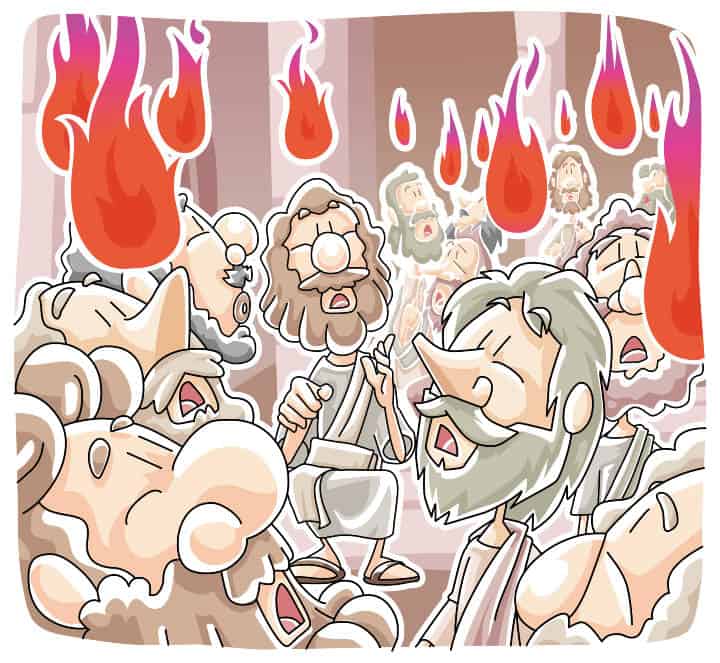
The church calendar events exhibit a pattern of patience…we wait at Advent time for the coming of the Messiah. Following that, we wait throughout Lent as we reflect on the significance of that season. When Good Friday and then Easter come, we rejoice in celebration of the risen Lord. And then we marvel at the Ascension and its admonition to once again wait. For what? For how long? Jesus promised His disciples a rather vague “comforter” at an undisclosed time. For kids, the idea of the Holy Spirit can be elusive and confusing. It is the least tangible or definable of the Trinity elements. But in the story of Pentecost, we have a genuine encounter with the Spirit in a real and exciting way. This lesson covers that experience and what it means for us.
Age Range: Elementary ages (adaptable for older or younger)
Materials Required: Card stock; balloons; straws; streamers; pencils; push pins; blow dryer; markers (or other decorative materials); lighter (optional); pom-poms
Scripture Reference: Acts 2:1-47
Opening: Blown away…since this lesson will feature an element of wind power, start off with a human wind-powered game or two. Hand each child a balloon and instruct them to blow it up as much as possible. Then release the balloons and see how far they fly! Do they follow straight patterns? Do this a couple of times, and then tie off balloons or give them to students to keep (try to give each child a different color to ease confusion).
Next (or in place of balloon activity if you wish), play a special version of “air hockey”: give everyone a straw and a pom-pom. On direction, have children use the straws to blow the pom-poms from one designated point to another, seeing who can blow the fastest and most accurately.
Gather kids together and ask them how they managed to blow up the balloons and move the pom-poms. Could they see the air that blew through? No…so how do we know it was there? (it moved things and enabled “life”…so does the Holy Spirit!). Invite students to share what they know about the Holy Spirit…
Lesson: Begin the lesson with a quick review (or synopsis) of the Ascension story, reminding students of Christ’s departure into Heaven and emphasizing His promise to send the disciples a “helper” of sorts. What would this be? How would it look? Everyone wondered…meanwhile, the Jewish leaders were still out to arrest and squelch the Christians, so they were hiding out in a house:
When the day of Pentecost came, they were all together in one place.2 Suddenly a sound like the blowing of a violent wind came from heaven and filled the whole house where they were sitting. 3 They saw what seemed to be tongues of fire that separated and came to rest on each of them. 4 All of them were filled with the Holy Spirit and began to speak in other tongues[a] as the Spirit enabled them.
Provide a brief definition of “Pentecost,” relating back to its celebration in Jewish culture of the “Feast of Weeks” marking fifty Days after Passover, with modern Christian meaning relating to fifty days after Easter. This was already a holiday, and the disciples and new believers were gathered when a wind rushed in and filled the room, and tongues of flame appeared!
*Make the story interactive here: turn on a hair dryer or fan to represent the rushing wind; have students blow on each other (might be a good tic-tac opportunity); maybe even hold up a lighter (older students) to have tongues of “flame.” If you speak another language, start using some sentences (it doesn’t have to be perfect after all, so don’t be shy!). Or play some music with different languages to emphasize the spoken tongues element. For extra technology incorporation excitement, you might even pull up a phone “app” like Google Translate and show off…
Continue with the Scripture:
Now there were staying in Jerusalem God-fearing Jews from every nation under heaven. 6 When they heard this sound, a crowd came together in bewilderment, because each one heard their own language being spoken. 7 Utterly amazed, they asked: “Aren’t all these who are speaking Galileans? 8 Then how is it that each of us hears them in our native language? -Acts 2:5-8
So we have a few things here: a rushing wind, tongues of FIRE, and now this miraculous ability to speak in any language and instantly understand! Anyone who has studied languages can recognize how amazing that would be…but there were some skeptic naysayers:
13 Some, however, made fun of them and said, “They have had too much wine.” (Acts 2:13)
Peter defends the Christians in the following verses, explaining all about who Jesus was, why He came, what He did, and why they are gathered. When asked what to do,
Peter replied, “Repent and be baptized, every one of you, in the name of Jesus Christ for the forgiveness of your sins. And you will receive the gift of the Holy Spirit. 39 The promise is for you and your children and for all who are far off—for all whom the Lord our God will call.”
40 With many other words he warned them; and he pleaded with them, “Save yourselves from this corrupt generation.” 41 Those who accepted his message were baptized, and about three thousand were added to their number that day. –Acts 2:38-41
Peter promises that all who call on Jesus receive the Holy Spirit. Just what is this Spirit? Talk with students about special items that bear memories. Maybe a blanket or a picture have important meaning. These things are comforting. They remind us of someone special. The Holy Spirit is sort of like that. It wraps us up with God’s amazing love and reminds us of Jesus. It is the comforting helper that takes over when even we don’t know how to pray. But unlike the blanket, the Holy Spirit has a special power of its own that really makes things stir and move. Most importantly, it should stir in us a desire to serve God and further His kingdom.
Pentecost can really be considered the birthday of the church. It was in that event that things got started with the Christian community. So really, this can kick off a new year celebrating Christ!
Craft: The wind moves it…Create a wind-filled craft…a few options abound. You might opt to create a pinwheel (this will work best for older students):
Have students decorate a square piece of cardstock. Then fold it twice to form an “X” in the paper, and cut halfway up the lines of the X. Fold each corner to the center, and drive a thumb tack through the middle onto the eraser of a pencil. Give a big blow and watch it spin!
https://ministry-to-children.com/spirit-pinwheel-craft/
Another option is a wind sock: have children decorate a long strip of paper or card stock. Staple it into a circle, and have kids choose streamers to cut and attach. Include a piece of string to hang the wind sock if desired.
Alternatively, there is always the good old-fashioned homemade kite option! J
Attach a caption to the craft with the memory verse:
All the believers were together and had everything in common. -Acts 2:44
Close with prayer, thanking God for His Holy Spirit and what it means for us. Ask that we remember the importance of working together for Him and telling others about Him.

Some really helpful ways of sharing God’s truth about the Holy Spirit with kids – thank you!
But please, when answering the question of ‘Just what is this Holy Spirit?’, remember to share that Jesus said the Holy Spirit is NOT an ‘it’ (like some impersonal force), but rather a ‘He’ (see John 14:17, 15:26, 16:7-14) – Christ’s own, personal Spirit sent to live & work in Christ’s people.